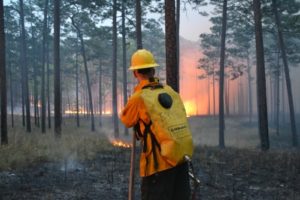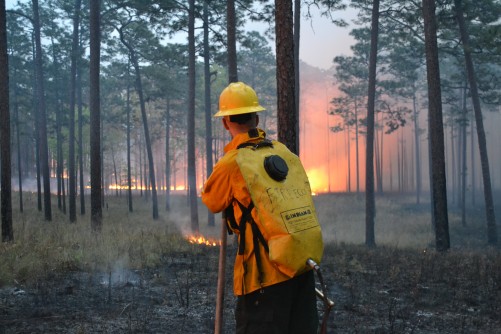The U.S. Forest Service is resuming its practice of intentionally lighting fires to clear brush and small trees from forested areas nationwide after a three-month hiatus to review the risks of runaway wildfires under increasingly severe climate conditions, the agency announced Thursday.
The prescribed fire program was put on hold in late May in the midst of a devastating wildfire sparked by the federal government near Las Vegas, New Mexico, that burned across more than 500 square miles (700 square kilometers) through remote communities in the southern reaches of the Rocky Mountains.
Forest Service Chief Randy Moore said prescribed burns will require new safeguards such as same-day authorization to keep pace with evolving weather and ground conditions.
He said the Forest Service will adopt mandatory tactics, taken from an in-depth review and public consultation process, that include a more robust scientific analysis of burn plans and a final on-site evaluation of the potential for human error linked to fatigue or inexperience.

Permission to light fires and other communications will be standardized to avoid missteps, amid efforts to learn from the small share of prescribed fires that escape control.
“It’s our due diligence and I can’t overstate that,” Moore said of the new safeguards and tactics. “Every time one of these fires happened, like the one down in New Mexico, you know, we lose trust and credibility in the communities that we serve and so we have to do this right.”
Moore said the agency won’t back away from intentional burns that he sees as a crucial tool in reducing the buildup of combustible material on forest floors and grasslands.
“Our climate is changing and we have the science to back that up,” Moore said. “We need to increase the amount of work that we’re doing by up to four times. We do feel that if we want to make a difference on that landscape, between forest thinning and prescribed burning, we really need to ramp it up. And we need to do it in a way that is safe, in a way that really instills public trust.”
By the end of the year, the agency also wants to expand training not only for Forest Service staff but also local community members who could be certified to participate directly in controlled wildfires.
To instill greater accountability, Moore said he will soon designate a specific Forest Service member at the national level to oversee implementation of the new requirements and tactics for prescribed burning.
Many forestry experts outside the federal government say prescribed burns need to be accompanied by better oversight and new scientific tools for modeling of fire behavior.
Owen Burney, director of the John T. Harrington Forestry Research Center at New Mexico State University, said the Forest Service could instill greater trust in prescribed burns with independent oversight from outside the agency – not just Forest Service administrators.
“I don’t think the Forest Service should be self-serving,” Harrington said. “What they need to have is external advisors.”
Anticipated changes to the prescribe burn program also will be geared toward economic development and the possible introduction of new composite building products made from small diameter trees and wood particles, products that might incentivize better forest management and create local jobs.
Was this article valuable?
Here are more articles you may enjoy.


 Wells Fargo Sued by Ex-Manager Who Said Bank Faked Diversity
Wells Fargo Sued by Ex-Manager Who Said Bank Faked Diversity  Trump Sues BBC for $10 Billion Over Documentary Edit
Trump Sues BBC for $10 Billion Over Documentary Edit  Twice Injured Firefighter Loses Second Workers’ Compensation Claim
Twice Injured Firefighter Loses Second Workers’ Compensation Claim  Jump Trading Faces $4 Billion Terraform Administrator Suit
Jump Trading Faces $4 Billion Terraform Administrator Suit 